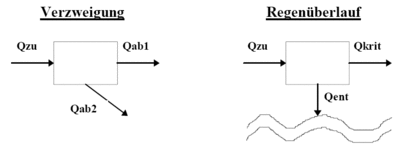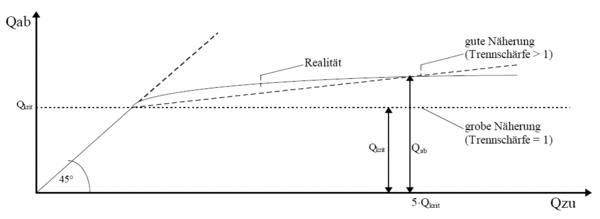Storm-water overflows: Difference between revisions
mNo edit summary |
m (moved Regenüberläufe to Storm-water overflows) |
||
| (2 intermediate revisions by 2 users not shown) | |||
| Line 3: | Line 3: | ||
[[Bild:Verzweigung.gif|thumb|left|400px]] | [[Bild:Verzweigung.gif|thumb|left|400px]] | ||
Branching points serve the purpose of dividing an inflow into two outflows according to a certain distribution specification. Branching points can be an intake structure in rivers for water supply or irrigation purposes,forks in a sewer system, diversions of a part of the inflow or outflow of a dam, storm-water overflows etc..<br clear="left"/> | |||
There are three possible approaches to define the distribution specification. | |||
==Threshold model (Option 1)== | |||
[[Bild:Theorie_Abb47b.gif|thumb|300px|Abbildung 47b: Outflow distribution using the threshold model approach.]] | |||
According to the threshold model the second outflow (e.g. storm-water overflow: outlet pipe) is applied only after a critical inflow Q<sub>krit</sub> has been reached, due to which the first outflow (e.g. storm-water overflow: throttle)backwater retention reaches the overflow crest. In reality a perfect distribution of the outflows after having reached the threshold value is usually not possible, therefore a selectivity can be specified for the structure to better represent real conditions. | |||
The selectivity is defined as: <math>\mbox{Trennschaerfe} = \frac{Q_{ab}(Q_{zu}=5 \cdot Q_{krit})}{Q_{krit}}</math> | |||
= | [[Bild:Theorie_Abb47.gif|thumb|left|600px|Abbildung 47: Definition selectivity parameter in BlueM]]<br clear="all"/> | ||
==Percentage distribution (Option 2)== | |||
== | Independent of inflow a constant distribution into two outflows <sub>ab1</sub> and Q<sub>ab2</sub> according to a certain percentage ratio occurs. Here too, one has the option to influence the distribution through scaling. | ||
==Characteristic curve (Option 3)== | |||
A dependency between outflow Q<sub>ab1</sub> and inflow, which was derived through hydraulic calculations or operating instructions, is utilized as a polygon course. The second outflow Q<sub>ab2</sub> is calculated as the residual value of inflow - Q<sub>ab1</sub>. | |||
{{HierarchieFuss}} | {{HierarchieFuss}} | ||
[[Kategorie:BlueM Theorie]] | [[Kategorie:BlueM Theorie]] | ||
Latest revision as of 23:40, 26 June 2013
{{#hierarchy-top:}}
Branching points serve the purpose of dividing an inflow into two outflows according to a certain distribution specification. Branching points can be an intake structure in rivers for water supply or irrigation purposes,forks in a sewer system, diversions of a part of the inflow or outflow of a dam, storm-water overflows etc..
There are three possible approaches to define the distribution specification.
Threshold model (Option 1)
According to the threshold model the second outflow (e.g. storm-water overflow: outlet pipe) is applied only after a critical inflow Qkrit has been reached, due to which the first outflow (e.g. storm-water overflow: throttle)backwater retention reaches the overflow crest. In reality a perfect distribution of the outflows after having reached the threshold value is usually not possible, therefore a selectivity can be specified for the structure to better represent real conditions.
The selectivity is defined as: [math]\displaystyle{ \mbox{Trennschaerfe} = \frac{Q_{ab}(Q_{zu}=5 \cdot Q_{krit})}{Q_{krit}} }[/math]
Percentage distribution (Option 2)
Independent of inflow a constant distribution into two outflows ab1 and Qab2 according to a certain percentage ratio occurs. Here too, one has the option to influence the distribution through scaling.
Characteristic curve (Option 3)
A dependency between outflow Qab1 and inflow, which was derived through hydraulic calculations or operating instructions, is utilized as a polygon course. The second outflow Qab2 is calculated as the residual value of inflow - Qab1.
{{#hierarchy-bottom:}}


